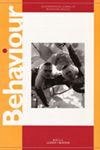An ethogram method for the analysis of human distress-related behaviours in the aftermath of public conflicts
IF 1
4区 生物学
Q4 BEHAVIORAL SCIENCES
引用次数: 0
Abstract
Abstract Research on other than human animals has widely documented the behavioural expression of distress in a conflict context. In humans, however, this remains largely unknown due to the lack of direct access to real-life conflict events. Here, we took the aftermath of 76 video recorded street conflicts and applied the ethological method to explore the distress-related behavioural cues of previous antagonists. Drawing on observations on nonhuman behaviour and inductively identified behaviours, we developed and inter-coder reliability tested an ethogram for the behavioural repertoire of distress. We further quantitively analysed the behaviours with a correlation matrix and PCA, that revealed that the behaviours we observed were not displayed in combination with each other, showing a variability in how people express distress. Since both human and nonhuman primates react to conflict situations with similar expressions of distress, we suggest a comparative approach to understand the evolutionary roots of human behaviour.一种用于分析公共冲突后人类痛苦相关行为的直方图方法
摘要对人类以外动物的研究已经广泛记录了冲突情境下痛苦的行为表达。然而,在人类中,由于缺乏直接接触现实生活中的冲突事件的机会,这在很大程度上仍然未知。在这里,我们选取了76个街头冲突的视频记录,并应用行为学方法来探索先前对抗者的痛苦相关行为线索。根据对非人类行为和归纳识别行为的观察,我们开发了一种痛苦行为表,并对编码器间的可靠性进行了测试。我们进一步用相关矩阵和PCA对这些行为进行了定量分析,结果显示,我们观察到的行为并没有相互结合,这表明人们表达痛苦的方式存在差异。由于人类和非人类灵长类动物对冲突情境的反应与痛苦的表达相似,我们建议采用比较的方法来理解人类行为的进化根源。
本文章由计算机程序翻译,如有差异,请以英文原文为准。
求助全文
约1分钟内获得全文
求助全文
来源期刊

Behaviour
生物-动物学
CiteScore
1.80
自引率
7.70%
发文量
44
审稿时长
3 months
期刊介绍:
Behaviour is interested in all aspects of animal (including human) behaviour, from ecology and physiology to learning, cognition, and neuroscience. Evolutionary approaches, which concern themselves with the advantages of behaviour or capacities for the organism and its reproduction, receive much attention both at a theoretical level and as it relates to specific behavior.
 求助内容:
求助内容: 应助结果提醒方式:
应助结果提醒方式:


